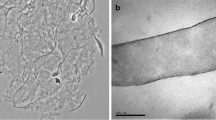Abstract
The growth of Alkaliflexus imshenetskii and concentrations of metabolites produced by this microorganism during growth on various organic substrates were studied. It was shown that, although the composition and quantitative ratios of the fermentation products depended on the substrates utilized, acetate and succinate were always the major metabolites, while only minor amounts of formate were produced. During growth on xylan and starch, diauxy was observed caused by the successive decomposition of oligosaccharides and monosaccharides. It was demonstrated that, when grown on cellobiose, A. imshenetskii is capable of succinate fermentation mediated by phosphoenolpyruvate carboxykinase, pyruvate kinase, fumarate reductase, pyruvate ferredoxin oxidoreductase, malate dehydrogenase, and methylmalonyl-CoA decarboxylase. Succinate may be both the intermediate and final product of the A. imshenetskii metabolism, being fermented to propionate by methylmalonyl-CoA decarboxylase.
Similar content being viewed by others
References
Zhilina, T.N., Appel, R., Probian, C., Brossa, E.L., Harder, J., Widdel, F., and Zavarzin, G.A., Alkaliflexus imshenetskii gen. nov.,sp. nov. a New Alkaliphilic Gliding Carbohydrate-Fermenting Bacterium with Propionate Formation from a Soda Lake, Arch. Microbiol., 2004, vol. 182, no. 2–3, pp. 244–253.
Denger, K., Warhmann, R., Ludwig, W., and Schink, B., Anaerofaga thermohalophila gen. nov., sp. nov., a Moderately Thermohalophilic, Strictly Anaerobic Fermentative Bacterium, Int. J. Syst. Evol. Microbiol., 2002, vol. 52, pp. 173–178.
Scheifinger, C.C. and Wolin, M.J., Propionate Formation from Cellulose and Soluble Sugars by Combined Cultures of Bacteroides succinogenes and Selenomonas ruminantium, Appl. Microbiol., 1973, vol. 26, pp. 789–795.
Macy, J.M., Ljungdahl, L.G., and Gottschalk, G., Pathway of Succinate and Propionate Formation in Bacteroides fragilis, J. Bacteriol., 1978, vol. 134, pp. 84–91.
De Vries, W., Rietveld-Struijk, R.M., and Stouthamer, A.H., ATP Formation Associated with Fumarate and Nitrate Reduction in Growing Cultures of Veillonella alcalescens, Antonie Van Leeuwenhoek. J. Microbiol. Serol., 1977, vol. 43, pp. 153–167.
Hilpert, W. and Dimroth, P., Conversion of the Chemical Energy of Methylmalonyl-CoA Decarboxylation into a Na+ Gradient, Nature, 1982, vol. 296, pp. 584–585.
Hilpert, W., Schink, B., and Dimroth, P., Life by a New Decarboxylation-Depent Energy Conversion with Na+ as Coupling Ion, EMBO J., 1984, vol. 3, pp. 1665–1670.
Pfenning, N. and Lippert, K.D., Über Das Vitamin B-Bedürfnis Phototropher Schwefelbakterien, Arch. Microbiol., 1966, vol. 55, pp. 245–246.
Wolin, E.A., Wolin, M.J., and Wolfe, R.S., Formation of Methane by Bacterial Extracts, J. Biol. Chem., 1963, vol. 238, pp. 2882–2886.
Lowry, O.H., Rosenbrough, N.J., Farr, A.L., and Rendall, R.J., Protein Measurement with the Folin Phenol Reagent, J. Biol. Chem., 1951, vol. 193, pp. 265–275.
Melville, S.B., Michel, T.A., and Macy, J.M., Pathway and Sites for Energy in the Metabolism of Glucose by Selenomonas ruminantium, J. Bacteriol., 1988, vol. 170, pp. 5298–5304.
Cardenas, J., Dyson, R., and Strandholm, J., Bovine Pyruvate Kinases. Purification and Characterization of the Skeletal Muscle Isozyme, J. Biol. Chem., 1973, vol. 248, p. 6931.
Zeikus, J.G., Chemical and Fuel Production by Anaerobic Bacteria, Annu. Rev. Microbiol., 1980, vol. 34, pp. 423–464.
Zeikus, J.G., Jain, M.K., and Elankovan, P., Biotechnology of Succinic Acid Production and Markets for Derived Industrial Products, Appl. Microbiol. Biotechnol., 1999, vol. 51, pp. 545–552.
Lee, P.C., Lee, W.G., Kwon, S., Lee, S.Y., and Chang, H.N., Succinic Acid Production by Anaerobiospirillum succiniciproducens: Effects of the H2/CO2 Supply and Glucose Concentration, Enzyme Microb. Technol., 1999, vol. 24, pp. 549–554.
Van der Welf, M.J., Guettler, M.V., Jain, M.K., and Zeikus, J.G., Environmental and Physiological Factors Affecting the Succinate Product Ratio During Carbohydrate Fermentation by Actinobacillus sp. 130Z, Arch. Microbiol., 1997, vol. 167, pp. 332–342.
Samuelov N.S., Lamed R., Lowe S., Zeikus J.G. Influence of CO2-HCO −3 Levels and pH on Growth, Succinate Production, and Enzyme Activities of Anaerobiospirillum succiniciproducens, Appl. Environ. Microbiol., 1991, vol. 57, pp. 3013–3019.
Author information
Authors and Affiliations
Corresponding author
Additional information
Original Russian Text © E.N. Detkova, M.V. Zaichikova, V.V. Kevbrin, 2009, published in Mikrobiologiya, 2009, Vol. 78, No. 3, pp. 310–316.
Rights and permissions
About this article
Cite this article
Detkova, E.N., Zaichikova, M.V. & Kevbrin, V.V. Physiological and biochemical properties of the alkaliphilic anaerobic hydrolytic bacterium Alkaliflexus imshenetskii . Microbiology 78, 273–279 (2009). https://doi.org/10.1134/S0026261709030035
Received:
Published:
Issue Date:
DOI: https://doi.org/10.1134/S0026261709030035




